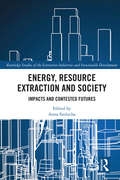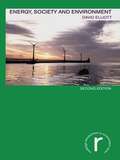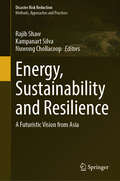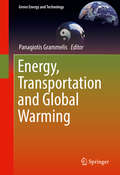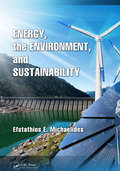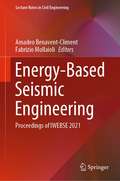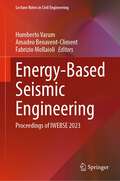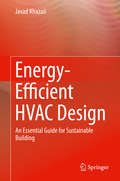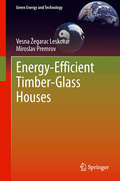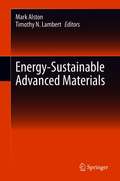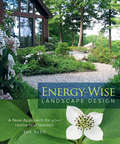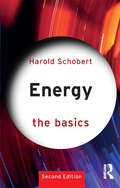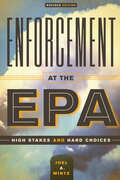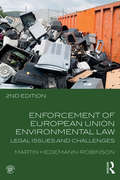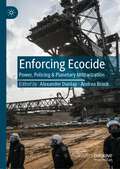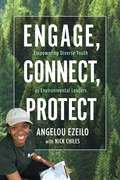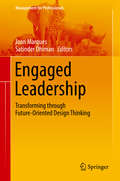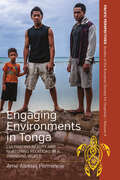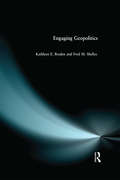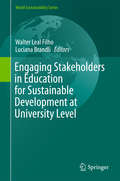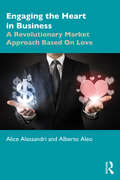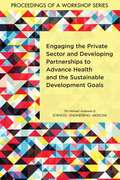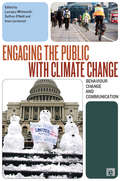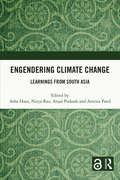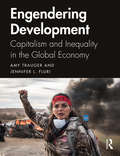- Table View
- List View
Energy, Resource Extraction and Society: Impacts and Contested Futures (Routledge Studies of the Extractive Industries and Sustainable Development)
by Anna SzoluchaEnergy is central to the fabric of society. This book revisits the classic notions of energy impacts by examining the social effects of resource extraction and energy projects which are often overlooked. Energy impacts are often reduced to the narrow configurations of greenhouse gas emissions, chemical spills or land use changes. However, this neglects the fact that the way we produce, distribute and consume energy shapes society, political institutions and culture. The authors trace the impacts of contemporary energy and resource extraction developments and explain their significance for the shaping of powerful social imaginaries and a reconfiguration of political and democratic systems. They analyse not only the complex histories and landscapes of industrial mining and energy development, including oil, coal, wind power, gas (fracking) and electrification, but also their significance for contested energy and social futures. Based on ethnographic and interdisciplinary research from around the world, including case studies from Australia, Germany, Kenya, the Netherlands, Nicaragua, Norway, Poland, Turkey, UK and USA, they document the effects on local communities and how these are often transformed into citizen engagement, protest and resistance. This sheds new light on the relationship between energy and power, reflecting a wide array of pertinent impacts beyond the usual considerations of economic efficiency and energy security. The volume is aimed at advanced students and researchers in anthropology, sociology, human geography, science and technology studies, environmental studies and sustainable development as well as professionals working in the field of impact assessments.
Energy, Society and Environment (Routledge Introductions to Environment: Environment and Society Texts)
by David ElliottSociety's use of energy and technology is at heart of many of the most significant environmental problems of recent years, including problems of health, global warming and acid rain. Use of technology has been a major cause of environmental problems but new technology offers many solutions.Energy, Society and Environment is an introduction to energy and energy use, and the interactions between technology, society and the environment. The book is clearly structured to examine:* key environmental issues, and the harmful impacts of energy use* new technological solutions to environmental problems* implementation of possible solutions* implications for society in developing a sustainable approach to energy use.Social processes and strategic solutions to problems are located within a clear, technological context with topical case studies and informative diagrams illustrating key issues.Energy, Society and Environment examines the potential and limits of technical solutions to environmental problems and suggests the social, economic and political changes necessary to avoid serious environmental damage in the future.
Energy, Sustainability and Resilience: A Futuristic Vision from Asia (Disaster Risk Reduction)
by Rajib Shaw Kampanart Silva Nuwong ChollacoopThis book analyzes the experiences of energy, sustainability and resilience issues from different Asian countries and puts forward a futuristic vision of an energy sector for sustained development. Energy is at the core of development, but in energy generation, there are severe environmental implications in many cases. This clearly affects development and causes significant challenges to sustainability. Climate change and disasters have an effect on energy infrastructures and also make significant impacts on humans in terms of both shocks and stresses. Therefore, it is extremely important to understand the linkage of energy, sustainability and resilience. Asia is a hotspot of climate change and disasters, suffering from severe damages to the energy infrastructure of the countries there. At the same time, being a core of world development trajectories, Asia produces and consumes more energy in different sectors than any other part of the world. Also, however, Asia serves as a core region of innovative ideas in energy and related sectors.
Energy, Transportation and Global Warming
by Panagiotis GrammelisThis book presents a holistic view of climate change by examining a number of energy and transportation technologies and their impact on the climate. High-quality technical research results from specific test-cases around the globe are presented, and developments in global warming are discussed, focusing on current emissions policies from air and maritime transport to fossil fuel applications. Novel technologies such as carbon capture and storage are investigated together with the corresponding process and systems analysis, as well as optimization for mitigating CO2 emissions. Water resources management, waste water treatment, and waste management issues are also covered. Finally, biomass, hydrogen and solar energy applications are presented along with some insights on green buildings. Energy, Transportation and Global Warming is of great interest to researchers in the field of renewable and green energy as well as professionals in climate change management, the transportation sector, and environmental policy.
Energy, the Environment, and Sustainability (Mechanical and Aerospace Engineering)
by Efstathios E. MichaelidesEnergy and the Environment explains in simple terms what the energy demand is at the present, what the environmental effects of energy use are, and what can be accomplished to alleviate the environmental effects of energy use and ensure adequate energy supply. Though technical in approach, the text uses simple explanations of engineering processes and systems and algebra-based math to be comprehensible to students in a range of disciplines. Schematic diagrams, quantitative examples, and numerous problems will help students make quantitative calculations. This will assist them in comprehending the complexity of the energy-environment balance, and to analyze and evaluate proposed solutions.
Energy-Based Seismic Engineering: Proceedings of IWEBSE 2021 (Lecture Notes in Civil Engineering #155)
by Amadeo Benavent-Climent Fabrizio MollaioliThis volume gathers the latest advances, innovations, and applications in the field of seismic engineering, as presented by leading researchers and engineers at the 1st International Workshop on Energy-Based Seismic Engineering (IWEBSE), held in Madrid, Spain, on May 24-26, 2021. The contributions cover a diverse range of topics, including energy-based EDPs, damage potential of ground motion, structural modeling in energy-based damage assessment of structures, energy dissipation demand on structural components, innovative structures with energy dissipation systems or seismic isolation, as well as seismic design and analysis. Selected by means of a rigorous peer-review process, they will spur novel research directions and foster future multidisciplinary collaborations.
Energy-Based Seismic Engineering: Proceedings of IWEBSE 2023 (Lecture Notes in Civil Engineering #236)
by Humberto Varum Amadeo Benavent-Climent Fabrizio MollaioliThis book gathers the latest advances, innovations, and applications in the field of seismic engineering, as presented by leading researchers and engineers at the 2nd International Workshop on Energy-Based Seismic Engineering (IWEBSE), held in Porto, Portugal, on July 3–6, 2023. The book covers a diverse range of topics, including energy-based EDPs, damage potential of ground motion, structural modeling in energy-based damage assessment of structures, energy dissipation demand on structural components, innovative structures with energy dissipation systems or seismic isolation, as well as seismic design and analysis. Selected by means of a rigorous peer-review process, they will spur novel research directions and foster future multidisciplinary collaborations.
Energy-Efficient HVAC Design
by Javad KhazaiiThis book provides readers with essential knowledge enabling the successful design of today's new energy efficient HVAC systems. The author introduces important concepts such as Knowledge Categorization, Performance Based Design Standards, and Quantification of Uncertainty in Energy Modeling for Buildings. Pivotal topics that all HVAC and architectural engineers must master in order to navigate the green building renaissance are given focused attention, including the role of renewables, air quality, automatic controls, and thermal comfort. Relevant ASHRAE standards, as well as sustainability scoring systems such as BREEAM, HQE, LEED and CASBEE are explained in depth. Armed with the material contained in this practical reference, students and practitioners alike will become more effective and prepared for engineering success.
Energy-Efficient Timber-Glass Houses
by Vesna Žegarac Leskovar Miroslav PremrovThe book discusses combining timber and glass, two eco materials, with a view to developing an optimal contemporary energy-efficient house with an attractive design. Furthermore, the book connects an architectural design approach with structural research to show the possibilities of stabilizing the building with an increased size of the glazing. Research results where the glazing is considered as a load-bearing structural element are therefore presented in a manner leading to the development of an optimal model of the timber-glass house, considering both the structural and energy related aspects. The presented research work can be useful to designers and future experts in their planning of optimal energy-efficient timber buildings. The study is based on using timber and glass, which were previously neglected as construction materials. With suitable technological development and appropriate use, they are nowadays becoming essential construction materials as far as energy efficiency is concerned. However, their combined use is extremely complicated, from both the constructional point of view as well as from that of energy efficiency and sets multiple traps for designers. A good knowledge of their advantages and drawbacks is thus vitally important, which is shown in the present monograph. Energy-efficient timber-glass houses was selected by the Slovenian National Research Agency as an extraordinary scientific achievement in the field of technical sciences/civil engineering for the year 2013.
Energy-Sustainable Advanced Materials
by Mark Alston Timothy N. LambertThis book highlights progress towards the capture, storage, and utilization of energy through the development of advanced materials and systems based on abundant elements, materials, and commodities. Energy is critical to human sustainability and a global-scale deployment of renewable energy systems will be required. Hence, the chapters integrate the fundamental aspects that enable the technical advancements in detail, along with an emphasis on the need for highly sustainable materials to enable real impact for humankind: To determine innovation of energy capture and storage through characterizations of materials in areas of electrical generation and electrical storage systems; To demonstrate better performance, economic and environmental advantages than the current state of the art; To define new chemistries and materials for innovations in energy density design through lower operational temperatures, improve safety, expanding operational voltage, battery durability lifetimes, and reduce system costs. Advances critical technical and commercial objectives for novel high energy density materials;Evaluates operational material models for optimizing energy capture that are integrated by configurations as a system; Illustrates utilization of material life cycle assessment for high energy outputs generators for sustainable materials.
Energy-Wise Landscape Design
by Sue ReedResidential consumption represents nearly one quarter of North America's total energy use and the average homeowner spends thousands of dollars a year on power bills. To help alleviate this problem, Energy-Wise Landscape Design presents hundreds of practical ways everyone can save money, time, and effort while making their landscapes more environmentally healthy, ecologically rich, and energy efficient.Combining general guidelines with tips, techniques, and actions, this fully illustrated guide explains the many opportunities our landscapes provide for conserving energy. Readers will learn how to: Lower a home's heating and cooling costs Minimize fuel used in landscape construction, maintenance, and everyday use Choose landscape products and materials with lower embedded energy costs Make a positive difference without a major investment or change in lifestyle Intended for homeowners, gardeners, landscape professionals, and students, the design ideas in this book will work in every type of setting--large or small, hilly or flat, urban or rural. Written in non-scientific language with clear explanations and an easy conversational style, Energy-Wise Landscape Design is an essential resource for everyone who wants to shrink their energy footprint while enhancing their property and adding value to their home.Sue Reed is a registered landscape architect and a specialist in ecological landscape design who has helped hundreds of homeowners create comfortable, livable, and beautiful landscapes that save energy. She is also an experienced writer and teacher whose work specifically focuses on environmentally sound, energy-efficient, and sustainable landscape design.
Energy: The Basics (The Basics)
by Harold SchobertEnergy: The Basics offers a concise and engaging introduction to energy, answering critical questions and providing accessible definitions of essential concepts and developments in the field.People rarely stop to think about where the energy they use to power their everyday lives comes from and when they do it is often to ask a worried question: is mankind’s energy usage killing the planet? How do we deal with nuclear waste? What happens when the oil runs out? Energy: The Basics answers these questions, but it also does much more. In this engaging yet even-handed introduction, readers are introduced to: the concept of ‘energy’ and what it really means the ways energy is currently generated and the sources used new and emerging energy technologies such as solar power and biofuels the impacts of energy use on the environment including climate change This new edition has been updated throughout and includes a new chapter on energy storage, along with new material on transportation energy and batteries.Featuring explanatory diagrams and an extensive further reading list, this book is the ideal starting point for anyone interested in the impact and future of the world’s energy supply.
Enforcement at the EPA: High Stakes and Hard Choices, Revised Edition
by Joel A. MintzThe only published work that treats the historical evolution of EPA enforcement, this book provides a candid inside glimpse of a crucial aspect of the work of an important federal agency. Based on 190 personal interviews with present and former enforcement officials at EPA, the U.S. Department of Justice, and key congressional staff members—along with extensive research among EPA documents and secondary sources—the book vividly recounts the often tumultuous history of EPA’s enforcement program. It also analyzes some important questions regarding EPA’s institutional relationships and the Agency’s working environment. This revised and updated edition adds substantial new chapters examining EPA enforcement during the Clinton and George W. Bush administrations. Its treatment of issues of civil service decline and the applicability of captive agency theory is also new and original.
Enforcement of European Union Environmental Law: Legal Issues and Challenges
by Martin Hedemann-RobinsonOffering a detailed account of the various legal arrangements at European Union level, this book is an ideal reference tool for practitioners and legal scholars. As well as examining the principal sources of EU environmental law enforcement, it also contributes to the legal and political debates that surround the subject. Spanning three parts, the author examines the practical impact of the legal arrangements at Union level that are used to uphold EU environmental norms. Offering a comprehensive account of the current state of EU environmental law enforcement and the developments affecting it, Martin Hedemann-Robinson explores the role of the European Commission, the possibilities for private law enforcement, and the responsibilities of member state national authorities. Key legal developments that have occurred since the first edition have been incorporated, including new statutory developments and case law. Particular attention is paid to the impact of the 2007 Lisbon Treaty on foundational EU treaty provisions enabling the European Commission to take legal action against EU member states infringing Union environmental law, the establishment of a new legal architecture at Union level on the topic of environmental criminal policy, as well as increased EU legislative intervention in the area of environmental inspections. The impact of the 1998 Århus Convention on EU environmental law enforcement is also addressed in detail, including the influence of recommendations of the Århus Convention’s Compliance Committee.
Enforcing Ecocide: Power, Policing & Planetary Militarization
by Alexander Dunlap Andrea BrockPolicing and ecological crises – and all the inequalities, discrimination, and violence they entail – are pressing contemporary problems. Ecological degradation, biodiversity loss, and climate change threaten local communities and ecosystems, and, cumulatively, the planet as a whole. Police brutality, wars, paramilitarism, private security operations, and securitization more widely impact people – especially people of colour – and habitats. This edited collection explores their relationship, and investigates the numerous ways in which police, security, and military forces intersect with, reinforce, and facilitate ecological and climate catastrophe. Employing a case study-based approach, the book examines the relationships and entanglements between policing and ecosystems, revealing the intimate connection between political violence and ecological degradation.
Engage, Connect, Protect: Empowering Diverse Youth as Environmental Leaders
by Nick Chiles Angelou Ezeilo“Ezeilo artfully articulates the obscured problem of racism in the country’s environmental movement and unapologetically sets forth solutions.” —Elaine Brown, author of A Taste of PowerRevealing the deep and abiding interest that African American, Latino, and Native American communities—many of whom live in degraded and polluted parts of the country—have in our collective environment, Engage, Connect, Protect is part eye-opening critique of the cultural divide in environmentalism, part biography of a leading social entrepreneur, and part practical toolkit for engaging diverse youth. It covers:Why communities of color are largely unrecognized in the environmental movementHow to bridge the cultural divide and activate a new generation of environmental stewardsA curriculum for engaging diverse youth and young adults through culturally appropriate methods and activitiesResources for connecting mainstream America to organizations working with diverse youth within environmental projects, training, and employmentEngage, Connect, Protect is a wake-up call for businesses, activists, educators, and policymakers to recognize the work of grassroots activists in diverse communities and create opportunities for engaging with diverse youth as the next generation of environmental stewards, while the concern about the state of our land, air, and water continues to grow.“An accessible guide to respond to the inequities faced by persons of color marginalized by mainstream environmentalism.” —Dianne D. Glave, author of Rooted in the Earth“Highlights the cultural connection to nature that black and brown people have always had, and the need, for the sake of our physical, mental, and spiritual health, for it to be reclaimed.” —Kamilah Martin, Vice President at the Jane Goodall Institute
Engaged Leadership: Transforming Through Future Oriented Design Thinking (Management For Professionals)
by Satinder Dhiman Joan MarquesThis professional book examines the concept of engaged leadership. Specifically, it focuses on the need for leaders in personal and professional realms, for-profit and non-profit, to understand the importance of engagement in order to achieve enhanced satisfaction and motivation among stakeholders (including employees, shareholders, investors, supporters, customers, suppliers, the community, competitors, family, and partners), and hence, an augmented level of designed thinking, which leads to increased innovation and on-going leadership development. Divided into three sections—engaged leadership development at the personal level, implementation at the organizational level, and manifestation in practice—this book provides professionals, practitioners and policy makers as well as students with the tools and skills to lead actively and conscientiously and help them understand the importance of creativity and compassion for development. Engaged leadership operates on the fundamental principle that leaders have to first and foremost perceive themselves as leaders, and then engage in design thinking, as they will need to develop strategies to reach, encourage, and positively appeal to these stakeholder groups. Leadership is neither limited to those holding formal managerial position, nor to any particular setting. Leaders can be found everywhere, in all layers of society. Leadership is only possible, however, if one dares to perceive and define oneself as a leader. And only when leadership is adopted as a reality within one’s personal perception, can engaged leadership be applied. Featuring contributions from academics, scholars, and professionals from around the world, each providing cases, interactive questions and reflective notes, this book will be of interest to professionals, practitioners, policy makers, students and scholars interested in creative leadership, management, organizational behavior, and governance.
Engaging Environments in Tonga: Cultivating Beauty and Nurturing Relations in a Changing World (Pacific Perspectives: Studies of the European Society for Oceanists #9)
by Arne Aleksej PerminowOn March 11, 2011, a tsunami warning was issued for Tonga in Polynesia. On the low and small island of Kotu, people were unperturbed in the face of impending catastrophe. The book starts out from the puzzle of peoples’ responses and reactions to this warning as well as their attitudes to a gradual rise of sea level and questions why people seemed so unconcerned about this and the accompanying loss of land. The book is an ethnography of the relationship between people and their environment based on fieldwork over three decades.
Engaging Geopolitics
by Kathleen E Braden Fred M ShelleyEngaging Geopolitics provides a comprehensive introduction to the influence of geography, demography and economics on politics and international relations in the world in which we live today. The authors' expressed aim is to make geopolitics more accessible to undergraduate students, with the hope that the book will be an ideal starting pointing for those who will be moving vertically into more advanced courses in political geography or laterally into other concerns of international affairs.
Engaging Stakeholders in Education for Sustainable Development at University Level
by Walter Leal Filho Luciana BrandliThis book discusses the role of ESD stakeholders at university level, involving civil society and the private sector and public sectors (including local, national and intergovernmental bodies). In particular, it describes practical experiences, partnerships, networks, and training schemes for increasing the capacity of ESD and other initiatives aimed at promoting education for sustainable development taking place at institutions of higher education. In order to meet the pressing need for publications that may promote stakeholders' involvement in ESD in higher education, the book particularly focuses on state-of-the-art approaches, methods, initiatives and projects from around the world, illustrating the contribution of different stakeholder groups to sustainable development in higher education on an international scale.
Engaging the Heart in Business: A Revolutionary Market Approach Based On Love (Giving Voice to Values)
by Alice Alessandri Alberto AleoIn the wake of the profound upheavals that our society has been facing, the business world is undergoing change. Values such as trust, well-being, sustainability, and respect for human beings and their deeper ambitions are becoming increasingly important. Corporations and professionals can achieve and maintain success only if they can bring their relationship with their customers to a new, higher level. The condition that links the two is very similar to that created when we fall in love. The organizational models and marketing approaches based on the metaphor of war, and the inherent rhetoric of "command and control", are no longer valid; to form such a bond we need love. The authors are aware of this. Since 2013, in collaboration with international scholars, they have been studying the new market dynamics and the fundamental role of ethics in gaining commercial results. While their previous book Sales Ethics (2015) helped to set up and manage customer relationships based on trust and fairness, this new book will support you in building your business strategy and designing marketing tools (from customer analysis, to the definition of your offer and the style of communication, up to the positioning of prices and the management of resources) in the light of a new model, the Loving Business Model, which aims to make the customer fall in love with you, and you with your work. This book, like its predecessor, is the result of independent research conducted between Italy and the United States combined with the authors’ many years of professional experience. It contains the most up-to-date and effective techniques available in the modern marketing landscape, supported by case studies, concrete examples and activities, which will guide you to put your newly acquired knowledge into practice.
Engaging the Private Sector and Developing Partnerships to Advance Health and the Sustainable Development Goals: Proceedings of a Workshop Series
by Engineering Medicine National Academies of SciencesIn September 2015, the Sustainable Development Goals (SDGs) were adopted at the United Nations Development Summit to serve as a 15-year plan of action for all countries and people. The SDGs include 17 specific goals, and 169 associated targets that set out quantitative objectives across the social, economic, and environmental dimensions of sustainable development, all to be achieved by 2030. Health has been recognized as crucial for sustainable human development and an essential contributor to the economic growth of society. Beyond the goal to “ensure healthy lives and promoting well-being for all at all ages,” many of the other SDGs include targets that are essential to address the environmental and social determinants of health. Considering this context, the Forum on Public–Private Partnerships for Global Health and Safety convened a workshop series to examine potential opportunities to engage the private sector and develop partnerships to advance health and the SDGs. This publication summarizes the presentations and discussions from the workshop series.
Engaging the Public with Climate Change: Behaviour Change and Communication
by Lorraine Whitmarsh Irene Lorenzoni Saffron O'NeillDespite increasing public awareness of climate change, our behaviours relating to consumption and energy use remain largely unchanged. This book answers the urgent call for effective engagement methods to foster sustainable lifestyles, community action, and social change. Written by practitioners and academics, the chapters combine theoretical perspectives with case studies and practical guidance, examining what works and what doesn't, and providing transferable lessons for future engagement approaches. Showcasing innovative thought and approaches from around the world, this book is essential reading for anyone working to foster real and lasting behavioural and social change.
Engendering Climate Change: Learnings from South Asia
by Anjal Prakash Asha Hans Nitya Rao Amrita PatelThis book focuses on the gendered experiences of environmental change across different geographies and social contexts in South Asia and on diverse strategies of adapting to climate variability. The book analyzes how changes in rainfall patterns, floods, droughts, heatwaves and landslides affect those who are directly dependent on the agrarian economy. It examines the socio-economic pressures, including the increase in women’s work burdens both in production and reproduction on gender relations. It also examines coping mechanisms such as male migration and the formation of women’s collectives which create space for agency and change in rigid social relations. The volume looks at perspectives from India, Pakistan, Bangladesh and Nepal to present the nuances of gender relations across borders along with similarities and differences across geographical,socio-cultural and policy contexts. This book will be of interest to researchers and students of sociology, development, gender, economics, environmental studies and South Asian studies. It will also be useful for policymakers, NGOs and think tanks working in the areas of gender, climate change and development.
Engendering Development: Capitalism and Inequality in the Global Economy
by Jennifer L. Fluri Amy TraugerEngendering Development demonstrates how gender is a form of inequality that is used to generate global capitalist development. It charts the histories of gender, race, class, sexuality and nationality as categories of inequality under imperialism, which continue to support the accumulation of capital in the global economy today. The textbook draws on feminist and critical development scholarship to provide insightful ways of understanding and critiquing capitalist economic trajectories by focusing on the way development is enacted and protested by men and women. It incorporates analyses of the lived experiences in the global north and south in place-specific ways. Taking a broad perspective on development, Engendering Development draws on textured case studies from the authors’ research and the work of geographers and feminist scholars. The cases demonstrate how gendered, raced and classed subjects have been enrolled in global capitalism, and how individuals and communities resist, embrace and rework development efforts. This textbook starts from an understanding of development as global capitalism that perpetuates and benefits from gendered, raced and classed hierarchies. The book will prove to be useful to advanced undergraduate and graduate students enrolled in courses on development through its critical approach to development conveyed with straightforward arguments, detailed case studies, accessible writing and a problem-solving approach based on lived experiences.
